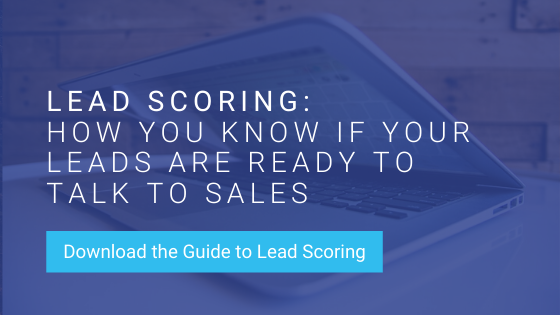What is Lead Scoring
Not all leads are created equal and for that very reason, we queue lead scoring. Lead scoring is ranking lead readiness to convert based on the lead’s behavior. The idea behind lead scoring is that certain activities speak to a lead’s readiness to be contacted by sales. A user who is highly engaged on the site, downloading multiple offers visiting key pages (like pricing), and signing up for the blog, etc. is (in theory) more ready to purchase than a user who visited one or two pages on the site a couple of times. Lead scoring allows a sales and marketing team to work together to develop criteria identifying leads likely to make a purchase so they can be followed up with by Sales.

Lead Scoring Process
1) Identifying Behaviors
The first step in lead scoring involves identifying activities that indicate lead readiness. You’ll have to throw back to your Consumer Behavior and Psychology 101 classes for this part. Think of actions your customers can take on your site that show they may be interested in purchasing. Maybe it’s downloading a content offer or visiting a specific page. Perhaps it’s the frequency of visits- is a user who visits the site four times in a month more likely to convert in a purchase than somebody who visited twice? Some examples of lead scoring behaviors include:
- Visiting the contact us page or abandoning the form
- Visiting the site X number of times in a month
- Viewing a key website page (like pricing or success stories)
- Completing a workflow
- Engaging with your company/posts on social media
- Downloading a content offer (ebook, how to guide, etc.)
Speaking of offers, download ours. Learn how to align your sales and marketing teams.
Identifying these behaviors requires the marketer to make assumptions based on the persona and expected & anticipated UX usage. But, involving sales here (smarketing alignment) will help your lead scoring be a more accurate depiction of what consumers are actually doing. What behaviors have your actual customers taken? Does Sales know of a common thread between all of their closed deals that you should be capitalizing on? On that note, look into what the actual data is saying as well. Pull some lists of “customer + fill-in-the-blank activity” and see what you come up with. You might find that all your customers visited the site over 5 times before submitting a contact us form. Or it might be that 80% of your customers all downloaded the same eBook. Include those findings in your list of behaviors. Think of and list out a total of 7-10 activities that indicate lead readiness.
2) Assigning Scores
Once you have identified your consumer behaviors, the next step is to assign points (or a score) to each of them. A score is usually between 1 and 5 points. Higher score = higher readiness to purchase. Before you begin, consider the weight on each activity. If you indeed found that 80% of your customers downloaded a particular ebook, you should probably give that activity a higher score than anything else. Signing up for the blog might get a lower score, like a 1, for instance, as it’s likely to be a relatively innocuous activity compared to others you might have listed.

Assigning a score to each behavior can be pretty subjective, even if you have data to back your claims. So again, we recommend including Sales in this part, too. Alignment here is critical as it opens a dialog between departments to create agreement on what a sales qualified lead looks like. [Click here to learn about putting that agreement on paper in the form of a Sales Level Agreement.] If you’re sending leads over that you think are perfectly qualified, but you haven’t involved Sales in the process, Sales might disregard the lead entirely. They might not know why they’re receiving leads that are, in their mind, “unqualified” while you’re thinking, “Look at this perfectly qualified lead!” The more you can work together, the happier you’ll be.
3) Select a Lead Score Threshold
Once you’ve assigned a score to each of the behaviors, it’s time to assign a lead score threshold. How many points does each lead need in order to deem them as ‘sales qualified’ and be passed to sales? This threshold will be entirely determined by the total points you distributed, the bandwidth of your sales team, and the overall precision you desire. For instance, if you have a sales team twiddling their thumbs, you may want to loosen your threshold so more leads get handed off. Conversely, if your sales team is saying, “We’re already slammed with web leads (yay!)! We only want people who are 97% ready to buy,” you should set a higher threshold so fewer, more qualified people get kicked over.
There’s a thin line here between being helpful and being creepy, though, so adjust your thresholds accordingly. You don’t want to be passing leads to be contacted by sales if they meet the threshold by only downloading an awareness offer and viewing the site twice in the last year. Your lead will be turned off by the over-eagerness of a ‘pushy’ salesperson. Make sure the threshold your setting will benefit both your users and your sales team. Early bird gets the worm, the second mouse gets the cheese.
4) CRM Setup
The whole point of lead scorning is to be able to pass more qualified leads over to be contacted by sales. So, the last step in the lead scoring process is to set everything up in your CRM. How to do this will be different for each CRM. In HubSpot, you set up your behaviors and scores and then create a workflow or a list to send all leads who meet your threshold over to sales automatically. [Click here for other automation tips.]
Once the train is moving, check back in periodically. How does Sales think it’s going? Are they closing the leads? Hungry for more? Decrease the threshold. Wasting time on people who aren’t interested yet? Increase the threshold. You also want to make sure you’re revisiting behaviors + scores as you make website updates, create new offers, and launch new workflows.



